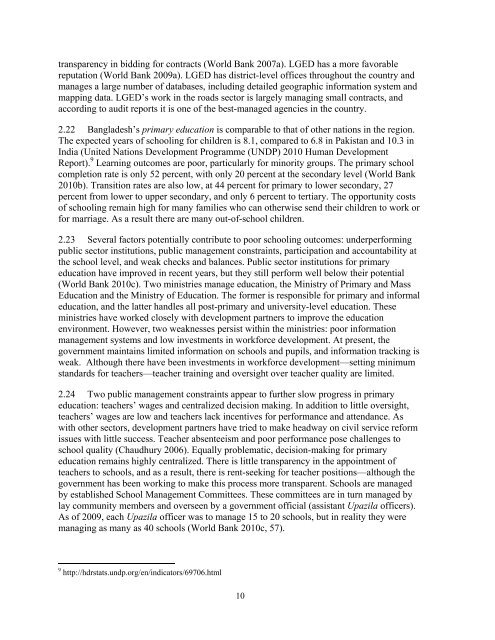Bangladesh - Independent Evaluation Group - World Bank
Bangladesh - Independent Evaluation Group - World Bank
Bangladesh - Independent Evaluation Group - World Bank
You also want an ePaper? Increase the reach of your titles
YUMPU automatically turns print PDFs into web optimized ePapers that Google loves.
transparency in bidding for contracts (<strong>World</strong> <strong>Bank</strong> 2007a). LGED has a more favorable<br />
reputation (<strong>World</strong> <strong>Bank</strong> 2009a). LGED has district-level offices throughout the country and<br />
manages a large number of databases, including detailed geographic information system and<br />
mapping data. LGED’s work in the roads sector is largely managing small contracts, and<br />
according to audit reports it is one of the best-managed agencies in the country.<br />
2.22 <strong>Bangladesh</strong>’s primary education is comparable to that of other nations in the region.<br />
The expected years of schooling for children is 8.1, compared to 6.8 in Pakistan and 10.3 in<br />
India (United Nations Development Programme (UNDP) 2010 Human Development<br />
Report). 9 Learning outcomes are poor, particularly for minority groups. The primary school<br />
completion rate is only 52 percent, with only 20 percent at the secondary level (<strong>World</strong> <strong>Bank</strong><br />
2010b). Transition rates are also low, at 44 percent for primary to lower secondary, 27<br />
percent from lower to upper secondary, and only 6 percent to tertiary. The opportunity costs<br />
of schooling remain high for many families who can otherwise send their children to work or<br />
for marriage. As a result there are many out-of-school children.<br />
2.23 Several factors potentially contribute to poor schooling outcomes: underperforming<br />
public sector institutions, public management constraints, participation and accountability at<br />
the school level, and weak checks and balances. Public sector institutions for primary<br />
education have improved in recent years, but they still perform well below their potential<br />
(<strong>World</strong> <strong>Bank</strong> 2010c). Two ministries manage education, the Ministry of Primary and Mass<br />
Education and the Ministry of Education. The former is responsible for primary and informal<br />
education, and the latter handles all post-primary and university-level education. These<br />
ministries have worked closely with development partners to improve the education<br />
environment. However, two weaknesses persist within the ministries: poor information<br />
management systems and low investments in workforce development. At present, the<br />
government maintains limited information on schools and pupils, and information tracking is<br />
weak. Although there have been investments in workforce development—setting minimum<br />
standards for teachers—teacher training and oversight over teacher quality are limited.<br />
2.24 Two public management constraints appear to further slow progress in primary<br />
education: teachers’ wages and centralized decision making. In addition to little oversight,<br />
teachers’ wages are low and teachers lack incentives for performance and attendance. As<br />
with other sectors, development partners have tried to make headway on civil service reform<br />
issues with little success. Teacher absenteeism and poor performance pose challenges to<br />
school quality (Chaudhury 2006). Equally problematic, decision-making for primary<br />
education remains highly centralized. There is little transparency in the appointment of<br />
teachers to schools, and as a result, there is rent-seeking for teacher positions—although the<br />
government has been working to make this process more transparent. Schools are managed<br />
by established School Management Committees. These committees are in turn managed by<br />
lay community members and overseen by a government official (assistant Upazila officers).<br />
As of 2009, each Upazila officer was to manage 15 to 20 schools, but in reality they were<br />
managing as many as 40 schools (<strong>World</strong> <strong>Bank</strong> 2010c, 57).<br />
9 http://hdrstats.undp.org/en/indicators/69706.html<br />
10

















